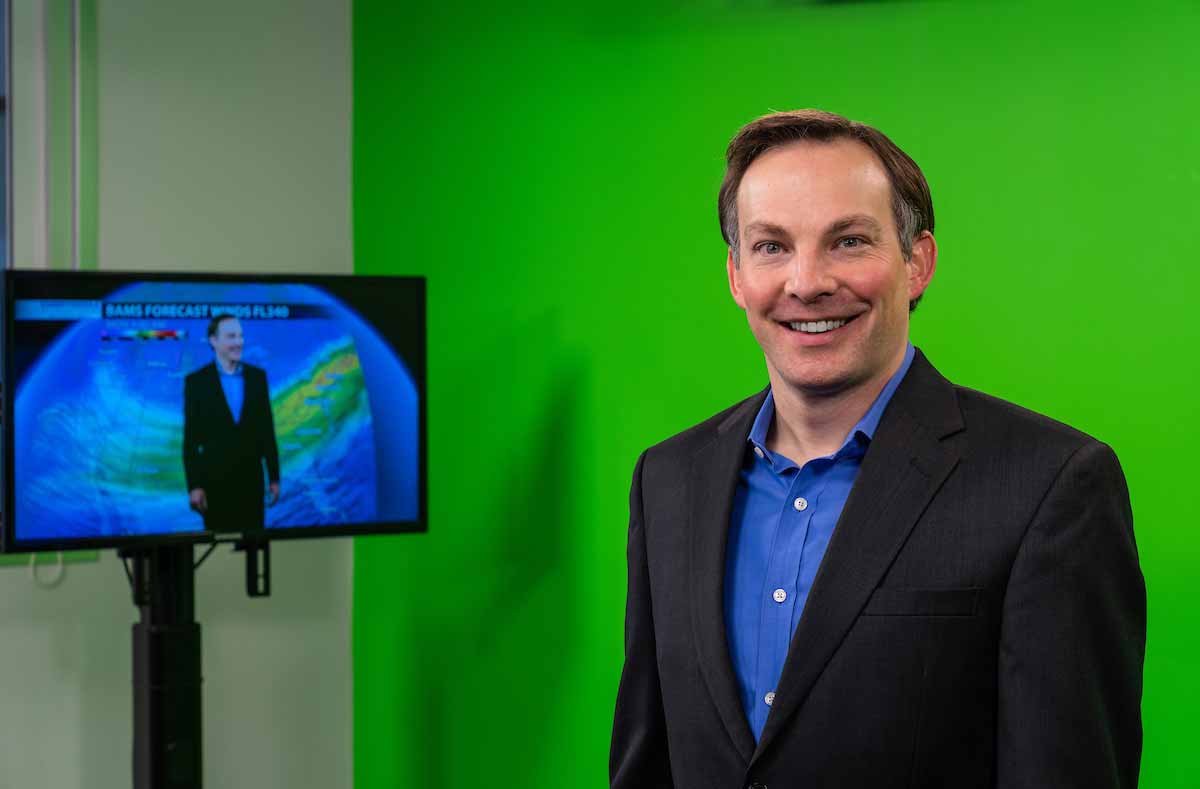Former Chief Meteorologist Leads Studio Upgrade, New Career Paths for Students

A new Broadcast Meteorology study track for Communication majors at the Daytona Beach Campus will offer exciting career options for students, according to new Assistant Professor of Meteorology Rob Eicher.
Rob Eicher, new assistant professor of Meteorology at Embry-Riddle, used to be terrified of thunderstorms.
“My interest in weather probably stemmed from my fear of thunderstorms as a very little kid,” he said. “I was scared to death. I wanted to understand what caused them so I’d be less afraid.”
That curiosity led to a nearly 20-year career as a broadcast meteorologist. Along the way, from 2005 to 2009, Eicher served as an adjunct faculty member and helped launch the Broadcast Meteorology program on Embry-Riddle’s Daytona Beach Campus. Now as full-time faculty, he’s taking the program to the next level, leading a major upgrade of the studio that will serve as a bedrock to the new Broadcast Meteorology Area of Concentration (AOC) for Communication majors.
“Communication students in this concentration will have the same opportunities in broadcasting that any other Meteorology student would have,” Eicher said. “Students now have two paths into the field.”
A Meteorology student with a Communication and Broadcast Media concentration might apply to jobs with news outlets after graduation or to jobs at the National Weather Service, he added; whereas, a Communication major with a Broadcast Meteorology concentration might pursue marketing or public relations positions at organizations like the National Oceanic and Atmospheric Administration (NOAA), in addition to on-air work with news outlets.
The new AOC will be available beginning the fall semester of 2019.
Communication Expands Career Opportunities
“Although the concentration is technically made up of weather courses offered in the Meteorology program, and a 400-level weather course may sound intimidating, it’s more about communicating science and being comfortable communicating technical details to a non-technical audience, and that’s a skill every employer is looking for,” Eicher said.
The place where communications and meteorology will converge is Eicher’s revamped studio.
Already, the upgraded studio features green screens, a teleprompter, 46-inch display monitors, and the ability to live-stream a broadcast to just about any digital platform in 4K resolution. It’s state-of-the-art – a studio on par with those found at any professional news station.
“Eventually, we can do news, sports and weather in here,” he said. “We’ve got industry-standard equipment. We’re where we need to be.”
Although these are technically weather courses offered in the Meteorology program … they’re more about being comfortable communicating technical details to a non-technical audience, and that’s a skill every employer is looking for.
Powered by the Baron: Lynx system, the studio now has the same graphics and data capabilities as those of many commercial TV studios across the country, according to Dr. Thomas Guinn, associate professor of Meteorology and Undergraduate Program Coordinator.
“It’s a major tech refresh,” Guinn said. “Rob streamlined the lab to give it a truly professional look and feel, and he’s modernizing our curriculum to include broadcasting via social media, which is where the industry is currently growing.”
The studio will also be used to broadcast faculty interviews into national news outlets. An additional green screen will be added to accommodate a full news set. And the software students will be using to design forecast graphics can upgrade visual aids used in classrooms throughout the university.
“One of my favorite attributes about Rob is that he’s a strong believer in collaboration,” Guinn added, noting that the new concentration will be available to students in the College of Aviation as well as the College of Arts & Sciences. “The new AOC in Broadcast Meteorology is a prime example. It only exists because of his willingness to work closely with other programs to help all programs flourish.”
Sharing On-Air Skills with Students
In the classroom, Eicher stresses the connections between his lessons and the real world, which is what his former student Vicki Graf (’07), an alumna who now works as a meteorologist and environmental reporter at Boston 25 News, appreciated most about his teaching style. Eicher was her first broadcast meteorology professor, and she calls him a mentor. She even still has her notes from his class and says that there are things he taught her back then that she uses in her career today.
“He was so experienced that he was able to pass along things that you can’t really learn just from a class,” she said — things like how broadcast meteorologists tend to advance through the industry, and what to expect from first jobs. Most importantly, he stressed that being successful in this field has as much to do with understanding the science as it does with knowing how to “tell the weather story.”
“He talked to us like we were on his level,” she remembered. “He was honest with us. He went above and beyond and helped us to get started in the business.”
Read more about Vicki Graf in an Alumni Spotlight titled "Alumna Reflects on Decade as TV Meteorologist"
Given how well Eicher knows the business, that makes sense. Throughout his career, he has transitioned through a variety of posts within the TV circuit: He served as chief meteorologist at a network-owned station in Charlotte, N.C., worked for a news station in Maryland, and another in Boston, Mass. He also broadcasted from three stations in Orlando, Fla.: News 13; WKMG, Channel 6; and WOFL, Channel 35 (watch his on-air highlight reel).
Being a TV weatherman, though, was never initially his plan. After applying for a summer job to work behind the scenes at a news outlet between grad school terms, he was offered a weekend on-air gig, despite a lack of industry experience.
“They said that all of their weather staff were not actual meteorologists, but journalists or people with communication degrees,” Eicher said. “They told me, If you come and teach us the weather, we’ll teach you how to do TV.”
That’s when his training started. He was assigned a talent coach, and after three weeks of lessons, he was deemed ready for air.
“A lot of the training was about how to appear comfortable on camera,” he said. “One big take-away that I teach my students is not to stare robotically at the TV. You have to turn and point at whatever you’re talking about so viewers will look at it, too.”
Now, away from the lights of the broadcast world, Eicher’s career has taken a turn — but he sees many similarities in the two sides of his career path.
“I like teaching people things they never knew about science and weather,” he said. “Doing it in a classroom has the same benefits of doing it on TV, without having to get up super early or wear makeup.”
Eicher stays active in the meteorological field — in January, he will begin serving as chair of the Board of Best Practices for the American Meteorological Society, a board for which he authored the first ever “Best Practices for Publicly Sharing Weather Information via Social Media” guidelines. He maintains a link to broadcasting, as well — in addition to freelancing at News 13 in Orlando, he currently raises his 18-month-old daughter, Riley, with his wife, Stephanie Coueignoux, an anchor/reporter at Fox 35 Orlando. Maintaining a foot in each camp is something that he, and every broadcast meteorologist, is used to. The ability to balance both “hard” and “soft” skills, for Eicher, is a necessity that extends to all career fields.
“No matter what industry you go into, you need good communication skills,” he said. “A lot of success is just being a good presenter.”

 Mike Cavaliere
Mike Cavaliere